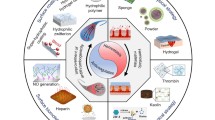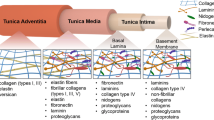Abstract
The optimal scaffold should have the self-organising property of activating the appropriate tissues surrounding the re-population. The anti-bacterial property of the coating was obtained through surface pre-treatment with coatings a few nanometres in thickness deposited using vapour-based methods. The coating’s anti-thrombogenic properties were obtained by the selective mobilisation of cellular functions, which was controlled by the structure of porous coatings deposited on bulk substrates and by the small biological agent-l-arginyl-glycyl-l-aspartic acid (tripeptide Arg-Gly-Asp-RGD) protein domains. Two tests simulating arterial flow conditions were performed: Impact-R, for examining platelet function under near physiological conditions, and radial flow chamber, a cell detachment test that gives an overview of cell behaviour and shear stresses that could appear between the cell and the biomaterial. Cell structures were analysed using laser scanning confocal microscopy and flow cytometry. The performed in vitro dynamic test for the haemo-compatibility revealed the most promising surface functionalization was based on porous extracellular-like structure covered with endothelium cells simultaneously. The antibacterial function was achieved by the appropriate phase composition of the coating used for the pre-treatment stage. The coating for the pre-treatment was selected on the basis of the blood-material and bacteria-material interaction.








Similar content being viewed by others
References
Chan MY, Weitz JI, Merhi Y, Harrington RA, Becker RC. Catheter thrombosis and percutaneous coronary intervention: fundamental perspectives on blood, artificial surfaces and antithrombotic drugs. J Thromb Thrombolysis. 2009;28:366–80.
Ratner BD. The catastrophe revisited: blood compatibility in the 21st Century. Biomaterials. 2007;28:5144–7.
Costerton B, Cook G, Shirtliff M, Stoodley P. Pasmore M. In: Ratner BD, Hoffman AS, Schoen FJ, Lemons JE, editors. Biomaterials Science. An introduction to materials in medicine. San Diego: Elsevier Academic; 2004. p. 345–54.
Chen L, Han D, Jiang L. On improving blood compatibility: from bioinspired to synthetic design and fabrication of biointerfacial topography at micro/nano scales. Colloids Surf B. 2011;85:2–7.
Bergseth G, Lambris JD, Mollnes TE, Lappegard KT. Artificial surface-induced inflammation relies on complement factor 5: proof from a deficient person. Ann Thorac Surg. 2011;91:527–33.
Stewart PS, Costerton JW. Antibiotic resistance of bacteria in bio-films. Lancet. 2001;358:135–8.
Mah T-FC, O’Toole GA. Mechanisms of biofilm resistance to antimicrobial agents. Trends Microbiol. 2001;9:34–9.
Khait L, Hecker L, Blan NR, Coyan G, Migneco F, Huang YC, Birla RK. Getting to the heart of tissue engineering. J Cardiovasc Trans Res. 2008;1:71–84.
Smith JA. Will tissue engineering become the 2lst century’s answer to cardiovascular disease? Heart Lung Circ. 2002;11:135–7.
Ballet T, Boulange L, Brechet Y, Buckert F, Weidenhaupt M. Protein conformational changes induced by adsorption onto material surfaces: an important issue for biomedical applications of material science. Bull Pol Acad Sci. 2010;58(2):303–15.
Zhang H-P, Lu X, Fang L-M, Weng J, Huang N, Leng Y. Molecular dynamics simulation of RGD peptide adsorption on titanium oxide surfaces. J Mater Sci Mater Med. 2008;19:3437–41.
Seo HS, KoY M, ShimJ W, LimY K, Kook J-K, Cho D-L, KimB H. Characterization of bioactive RGD peptide immobilized onto poly(acrylic acid) thin films by plasma polymerization. Appl Surf Sci. 2010;257:596–602.
Lackner JM. Industrially-scaled hybrid Pulsed Laser Deposition at Room Temperature. Krakow: Orekop sc., 2005. p 1-131.
Sefton MV, Gemmel CH. Nonthrombogenic treatments and strategies. In: Ratner BD, Hoffman AS, Schoen FJ, Lemons JE, editors. Biomaterials Science. An introduction to materials in medicine. San Diego: Elsevier Academic; 2004. p. 456–70.
Zhang X, Wang X, Keshav V, Wang X, Johanas JT, Leisk GG, Kaplan DL. Dynamic culture conditions to generate silk-based tissue-engineered vascular grafts. Biomaterials. 2009;30:3213–23.
http://www.sigmaaldrich.com/catalog/search?interface=All&term=Arg-Gly-Asp+A+8052&lang=pl®ion=PL&focus=documents&N=0+220003049+219853218+219853286&mode=match%20partialmax. Product Information Sheet: A8052.
Hersel U, Dahmen C, Kessler H. RGD modified polymers: biomaterials for stimulated cell adhesion and beyond. Biomaterials. 2003;24:4385–415.
Sanak M, Jakiela B, Wegrzyn W. Assessment of hemocompatibility of materials with arterial blood flow by platelet functional tests. Bull Pol Acad Sci Tech Sci. 2010;58(2):317–22.
http://impact-r.com/en/wp-content/uploads/2011/07/brochure-test-kit-Diamed-Impact-R1.pdf. Product-Identification: 47600.
Varont D, Dardiki R, Shenkmanl B, Kotev-Emeth S, Farzarne N, Tamarinl I, Savion N. A new method for quantitative analysis of whole blood platelet interaction with extracellular matrix under flow conditions. Thromb Res. 1997;85(4):293–4.
Major R, Lackner JM, Wilczek P, Sanak M, Jakiela B, Stolarzewicz B, Kowalczuk M, Sobota M, Maksymow K, Spisak M, Major B. Functional cardio-biomaterials. Adv Mater Sci. 2011;11(2):5–25.
Lackner JM, Waldhauser W, Alamanou A, Teichert C, Schmied F, Major L, Major B. Mechanisms for self-assembling topography formation in low-temperature vacuum deposition of inorganic coatings on polymer surfaces. Bull Pol Acad Sci Tech Sci. 2010;58(2):281–94.
Richert L, Boulmedais F, Lavalle P, Mutterer J, Ferreux E, Decher G, Schaaf P, Voegel J-C, Picart C. Improvement of stability and cell adhesion properties of polyelectrolyte multilayer films by chemical cross-linking. Biomacromolecules. 2004;5(2):284–94.
Germanier Y, Tosatti S, Broggini N, Textor M, Buser D. Enhanced bone apposition around bio-functionalized sandblasted and acid-etched titanium implant surfaces. A histo-morphometric study in miniature pigs. Clin Oral Implants Res. 2006;17(3):251–7.
Major R. Hybrid pulsed laser deposition of gradient TiN and Ti(C,N) coatings for biomedical applications (in English). Inzynieria Materialowa. 2007;157–156:666–71.
Lackner JM, Waldhauser W, Major R, Major L, Major B. Interface growth morphologies in pulsed laser deposited, room temperature grown multilayer hard coatings. Surf Coat Technol. 2006;201:4090–3.
Lackner JM, Waldhauser W, Berghauser R, Kahn M, Bruckert F, Major R, Major B. (2007) Detachment Kinetics of Eukaryote cells from bio-compatibile PVD coatings. Society of Vacuum Coaters; 505/856-7188 50th Annual Technical Conference Proceedings :113–116.
Chen JL, Li QL, Chen JY, Chen C, Huang N. Improving blood-compatibility of titanium by coating collagen–heparin multilayers. Appl Surf Sci. 2009;255:6894–900.
Meng N, Zhang SQ, Zhou NL, Shen J. Biopolymer-modified graphite oxide nano-composite films based on benzalkonium chloride-heparin intercalated in graphite oxide. Nanotechnology. 2010;21:185101. doi:10.1088/0957-4484/21/18/185101.
Singh V, Joung D, Zhai L, Das S, Khondaker SI, Seal S. Graphene based materials: past, present and future. Prog Mater Sci. 2011;56:1178–271.
Bernacca GM, Gulbransen MJ, Wilkinson R, Wheatley DJ. In vitro blood compatibility of surface-modified polyurethanes. Biomaterials. 1998;19:1151–65.
Acknowledgments
This research was supported financially by the project CardioBioMat MNT Era-Net-MNT/15/2009 “Nonstructural materials for implants and cardiovascular biomedical devices” under the National Centre of Research and Development. The experiments were executed with the cooperation of Jagiellonian University Medical College, Department of Medicine Cracow, Poland, Grenoble Institute National Polytechnique Minatec Phelma LMGP and JOANNEUM RESEARCH Forschungs-GmbH, MATERIALS—Functional Surfaces, Leoben, Austria.
Author information
Authors and Affiliations
Corresponding author
Rights and permissions
About this article
Cite this article
Major, R. Self-assembling surfaces of blood-contacting materials. J Mater Sci: Mater Med 24, 725–733 (2013). https://doi.org/10.1007/s10856-012-4824-y
Received:
Accepted:
Published:
Issue Date:
DOI: https://doi.org/10.1007/s10856-012-4824-y




